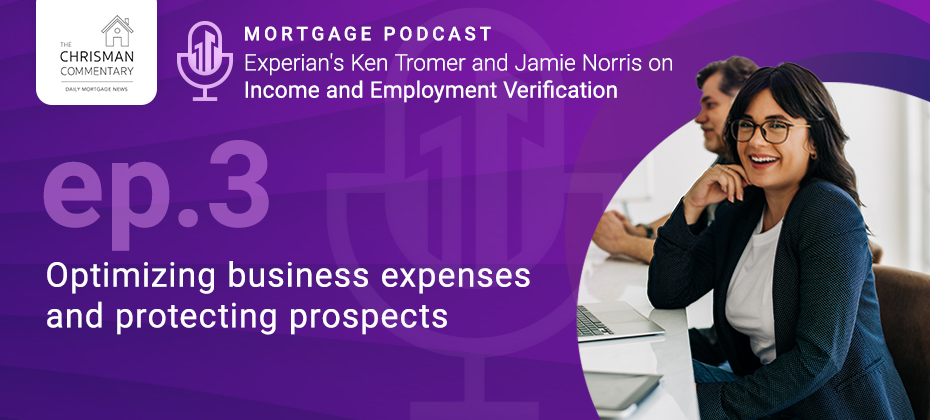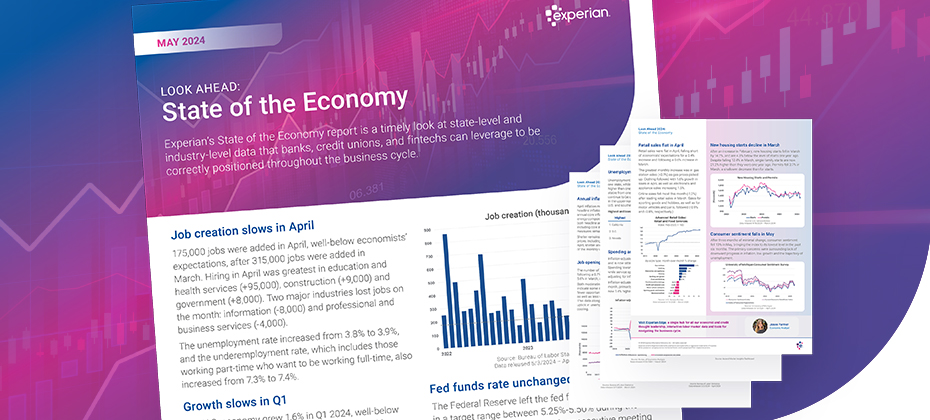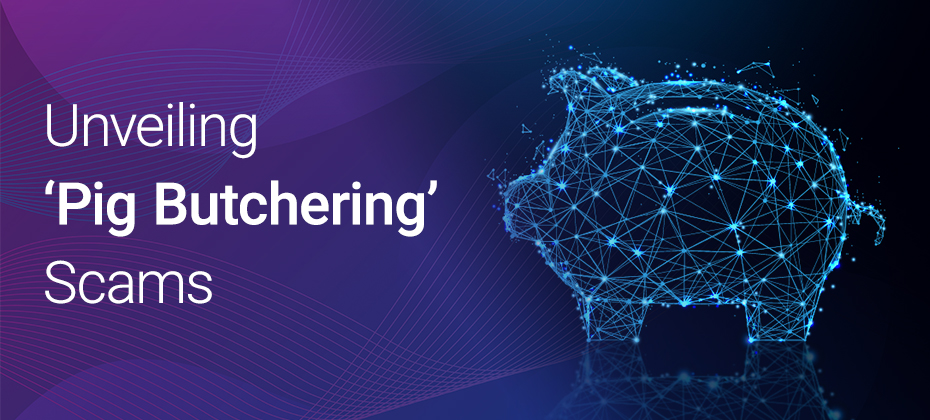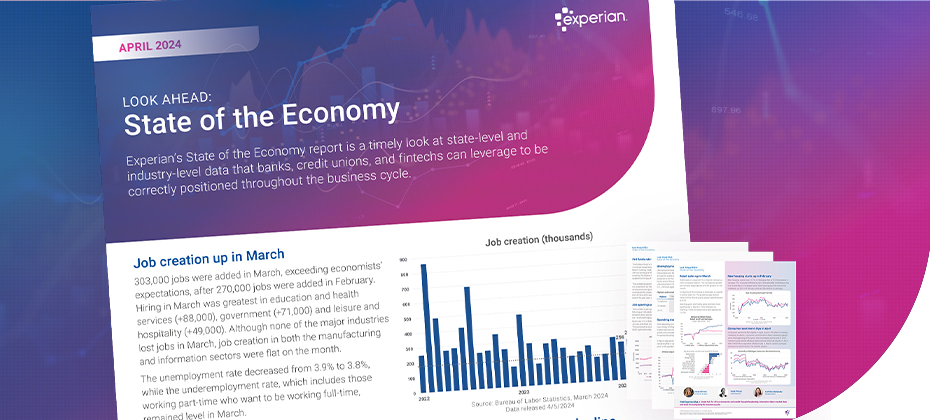Latest Posts

Mortgage lenders looking to attract first-time homebuyers must understand their needs, wants, and finances, especially as the economic environment and evolving generational trends shift. Understanding who this buyer segment is and what they buy unlocks growth potential for today’s attentive mortgage lenders. Financial diversity defines first-time homebuyers First-time homebuyers are searching for the attainable, which is not easy today. High interest rates, low housing inventory, and individual financial circumstances contribute to the hardships the housing market presents. Even with ups and downs and difficulties in the marketplace, first-time homebuyers continue to show their grit. Over two-thirds of first-time homebuyers have an annual household income over $90k, with 27% having household income over $180k. Additionally, Experian Housing research shows that 85% of first-time homebuyers have prime or super-prime credit scores. While credit and income play critical roles in evaluating borrower risk, they're not the only factors. The mortgage lending market is slowly leaning into the use of alternative credit data, such as rental payment information, to determine a borrower's creditworthiness. These changes are crucial in our industry's effort to support consumers on their journey towards homeownership. Financial realities impact property choices Experian Housing’s recent white paper looking at first-time purchasers shows over 85% buying single-family homes, with roughly 70% of these buyers belonging to Generation Y (Gen Y) and Generation Z (Gen Z). While starter homes suggest impermanence, Gen Y and Gen Z buying habits reflect their values and overall desire for stability. These motivated buyers that understand the economic woes, are adjusting and looking for options. More than three-fourths of first-time purchases are older homes, built before 2000. However, Experian’s same research showed sales of new construction homes (2021-2023) increased over the prior two years, particularly among first-time buyers. Builder credits and other incentives make new builds more appealing, and lenders leveraging their mortgage market expertise will be able to discuss options customized to the borrower, helping them make the decision best fitting their needs. Especially among younger generations, first-time homebuyers are considering different housing options in their path to homeownership. From multigenerational housing and co-owning a home with friends and family to smaller homes and moving further away for affordability reasons, options are on the table.1 Untapped potential for savvy lenders The modern mortgage landscape offers thoughtful lenders opportunities to drive growth. Diversity in the first-time homebuyer profiles means that lenders who distinguish themselves by tailoring their services to the borrower’s needs. This may include, but is certainly not limited to: Drawing on their knowledge of first-time homebuyer programs, grants and loans appropriate to the borrower. Improving their overall financial well-being with financial literacy education. Expertly guiding them through the complex lending process. Ensuring as swift and smooth a transaction as possible with timely and responsive communications. For more information about the lending possibilities for first-time homebuyers, download our white paper and visit us online. Download white paper Learn more 1 “Several Generations Under One Roof,” census.gov; “What to Know About Co-Buying A House,” myhome.freddiemac.com

In the previous episode of “The Chrisman Commentary” podcast, Joy Mina, Director of Product Commercialization at Experian, talked about the misconceptions associated with verifications and what organizations can do to enhance their strategies. In the latest episode, Experian's Ken Tromer and Jamie Norris discuss ways mortgage companies can optimize their business expenses and protect prospects. "The market has been asking for solutions to help with cost mitigation and lead protection for quite some time," said Jamie. "We've listened to the market and Power Profile Plus™ does just that." Listen to the full episode for all the details and learn more about Power Profile Plus™ for Mortgage. Listen to podcast Learn more

The morning kicked off with the buzz of innovation. Shri Santhanam, Financial Services and Data General Managers Platforms and Software, and leaders from Experian debuted the latest enhancements for the Experian Ascend Technology PlatformTM. The demo touted faster automation, seamless data integration, security and compliance, and simplified experience. Resiliency, security and gen AI capabilities are all core components and outputs of the new platform. Keynote speakers: Steffi Graf and Andre AgassiTennis icons Steffi Graf and Andre Agassi captivated the audience with stories of their memorable matches, how they met and their foray into pickleball. From notorious rivals to the pivotal moments that were part of their weeks at seeding in the number 1 position – 377 weeks and 101 weeks respectively. Keynote speaker: Jason SudeikisEmmy-award winning actor, comedian, writer and producer – and also known as the affable Ted Lasso – Jason Sudeikis had the crowd laughing reminiscing his favorite skits from his time at Saturday Night Live and outtakes from his numerous films. He talked about the impact of Ted Lasso and the origin of the “Believe” sign, as well as what’s ahead. Sessions – Day 2 highlights The conference hall was buzzing with conversations, discussions and thought leadership. Some themes definitely rose to the top — the increasing proliferation of fraud and how to combat it without diminishing the customer experience, leveraging AI and transformative technology in decisioning and how Experian is pioneering the GenAI era in finance and technology. Alternative dataAlternative data can be used to holistically measure a consumer's creditworthiness. Property data to banking insights to consumer-permissioned data and more can be a critical part of your strategies to segment, analyze and underwrite unbanked and new-to-credit consumers. EngagementEconomic headwinds and fierce competition in the banking industry have acquisition costs soaring, making it more important than ever to be critical of your organization’s advertising spend. Meanwhile, consumers are trending back toward the convenience of banking bundles, and they expect their financial institutions to help them improve their financial health. These conditions create a unique opportunity to extract value from digital experiences. CollectionsData, advanced analytics and machine learning are transforming all aspects of collections during a time when consumer debt pressure is building. Organizations can harness the power of data-driven insights, predictive modeling, enhanced segmentation and optimized decisions to ensure they have the strongest contact data and best collections strategy to reduce delinquencies and boost recovery rates. See you next year for Vision 2025!

This series will dive into our monthly State of the Economy report, providing a snapshot of the top monthly economic and credit data for those in financial services to proactively shape their business strategies. After again announcing no change in the target fed funds rate during their May meeting, the Federal Reserve continues to face the decision of when to begin cutting rates. The economic data released this month only complicated this decision, as growth came in well-below expectations and the labor market seemed to ease on several fronts. However, there was only minimal downward progress in inflation, especially considering the high prices seen over the past few months. In this month’s report, we dive into the data developments that comprise this economic story. Data highlights from this month’s report include: Economic growth in Q1 came in at 1.6%, under economists’ expectations. Underlying components of consumer spending and business investment remained solid. Inflation cooled in April, with annual headline inflation down from 3.5% to 3.4% and annual core inflation down from 3.8% to 3.6%. Consumer sentiment fell 13% in May, due to stubborn inflation, low growth, and easing in the labor market. Check out our report for a deep dive into the rest of this month’s data, including the latest trends in job creation, spending, and the fed funds rate. Download May's State of the Economy report To have a holistic view of our current environment, it’s important to view the economy from different angles and through different lenses. Watch our team of experts discuss the latest economic and credit trends in the recording of our latest macroeconomic forecasting webinar, download our latest forecast scenario report, or listen to our latest Econ to Action podcast for views on the economic environment in different market segments. For more economic trends and market insights, visit Experian Edge.

Experian’s award-winning platform now brings together market-leading data, generative AI and cutting-edge machine learning solutions for analytics, credit decisioning and fraud into a single interface — simplifying the deployment of analytical models and enabling businesses to optimize their practices. The platform updates represent a notable milestone, fueled by Experian’s significant investments in innovation over the last eight years as part of its modern cloud transformation. “The evolution of our platform reaffirms our commitment to drive innovation and empower businesses to thrive. Its capabilities are unmatched and represent a significant leap forward in lending technology, democratizing access to data in compliant ways while enabling lenders of all sizes to seamlessly validate their customers’ identities with confidence, help expand fair access to credit and offer awesome user and customer experiences,” said Alex Lintner CEO Experian Software Solutions. The enhanced Experian Ascend Platform dramatically reduces time to install and offers streamlined access to many of Experian's award-winning integrated solutions and tools through a single sign-on and a user-friendly dashboard. Leveraging generative AI, the platform makes it easy for organizations of varying sizes and experience levels to pivot between applications, automate processes, modernize operations and drive efficiency. In addition, existing clients can easily add new capabilities through the platform to enhance business outcomes. Read Press Release Learn More Check out Experian Ascend Platform in the media: Transforming Software for Credit, Fraud and Analytics with Experian Ascend Platform™ (Episode 160) Reshaping the Future of Financial Services with Experian Ascend Platform Introducing Experian’s Cloud-based Ascend Technology Platform with GenAI Integration 7 enhancements of Experian Ascend Platform

“Learn how to learn.” One of Zack Kass’, AI futurist and one of the keynote speakers at Vision 2024, takeaways readily embodies a sentiment most of us share — particularly here at Vision. Jennifer Schulz, CEO of Experian, North America, talked about AI and transformative technologies of past and present as she kicked off Vision 2024, the 40th Vision. Keynote speaker: Dr. Mohamed El-Erian Dr. Mohamed El-Erian, President of Queens’ College, Cambridge and Chief Economic Advisor at Allianz, returned to the Vision stage to discuss the labor market, “sticky” inflation and the health of consumers. He emphasized the need to embrace and learn how to talk to AI engines and that AI can facilitate content, creation, collaboration and community Keynote speaker: Zack Kass Zack Kass, AI futurist and former Head of Go-To-Market at OpenAI, spoke about the future of work and life and artificial general intelligence. He said AI is aiding in our entering of a superlinear trajectory and compared the thresholds of technology versus those of society. Sessions – Day 1 highlights The conference hall was buzzing with conversations, discussions and thought leadership. Some themes definitely rose to the top — the increasing proliferation of fraud and how to combat it without diminishing the customer experience, leveraging AI and transformative technology in decisioning and how Experian is pioneering the GenAI era in finance and technology. Transformative technologiesAI and emerging technologies are reshaping the finance sector and it's the responsibility of today's industry leaders to equip themselves with cutting-edge strategies and a comprehensive understanding to master the rapidly evolving landscape. That said, transformation is a journey and aligning with a partner that's agile and innovative is critical. Holistic fraud decisioningGenerative AI, a resurgence of bank branch transactions, synthetic identity and pig butchering are all fraud trends that today's organizations must be acutely aware of and armed to protect their businesses and customers against. Leveraging a holistic fraud decisioning strategy is important in finding the balance between customer experience and mitigating fraud. Unlocking cashflow to grow, protect and reduce riskCash flow data can be used not only across the lending lifecycle, but also as part of assessing existing portfolio opportunities. Incorporating consumer-permissioned data into models and processes powers predicatbility and can further assess risk and help score more consumers. Navigating the economyAmid a slowing economy, consumers and businesses continue to struggle with higher interest rates, tighter credit conditions and rising delinquencies, creating a challenging environment for lenders. Experian's experts outlined their latest economic forecasts and provided actionable insights into key consumer and commercial credit trends. More insights from Vision to come. Follow @ExperianVision and @ExperianInsights to see more of the action.

With e-commerce booming and more transactions occurring online, the threat of chargeback fraud has never been more significant. In this article, we'll explore chargeback fraud, why it's a growing problem, and, most importantly, how to prevent it. Whether you're a small or large business, understanding and implementing robust chargeback fraud prevention measures is critical to protecting your organization. Understanding chargeback fraud Before we can prevent chargeback fraud, we need to know what we're dealing with. A chargeback happens when a cardholder disputes a transaction, or files a chargeback request, leading to the reversal of the payment to the merchant. Chargebacks can occur for various reasons including: Fraudulent transactions: If a card is stolen or its information is used without authorization, like in the case of account takeover fraud or card not present fraud, the cardholder can dispute the charges. Unauthorized transactions: Even if the cardholder didn't lose their card, they might notice charges they didn't make. Quality issues: If the product or service doesn't meet the cardholder's expectations or has a defect, they might dispute the charge. Billing errors: Sometimes, billing mistakes happen, such as being charged multiple times for the same transaction. Subscription cancellations: When a cardholder cancels a subscription but continues to be billed they can dispute the charges. While there are legitimate reasons for chargebacks, chargeback fraud, also known as friendly fraud, occurs when a customer makes a legitimate purchase with their credit card and then disputes the charge by filing a chargeback request. Unlike third-party fraud, where the cardholder's information is stolen or used without permission, in chargeback fraud, the cardholder initiates the dispute to avoid paying for goods or services they legitimately received. Chargeback fraud can take various forms: False claims of non-receipt: The cardholder claims they never received the purchased item, even though they did. Unauthorized transaction claims: The cardholder denies making the purchase, even though they did so legitimately. Product/service dissatisfaction: The cardholder claims dissatisfaction with the product or service as a reason for disputing the charge, even if the product or service was as described. Subscription services: The cardholder signs up for a subscription service and then disputes the recurring charges as unauthorized or unwanted. Why chargeback fraud is on the rise Chargeback fraud is becoming more pervasive for a couple of reasons. First, as e-commerce grows, so does the opportunity for fraud. Without face-to-face interactions, fraudsters can pull off their schemes more easily. Second, the process of issuing chargebacks has become consumer-friendly, with banks often siding with the cardholder without deep scrutiny of the claim. Finally, with the rise of subscription-based services and digital goods, the incidence of "friendly fraud" is increasing. The impact and repercussions of chargeback fraud The impact of chargeback fraud can be felt across several areas within a business. Financially, it's a clear and direct loss. There are also significant operational costs associated with managing chargebacks, including potential product loss, bank and related fees, and administrative work. However, the less tangible, more insidious repercussions involve damage to the business's reputation. A high chargeback rate can lead to a merchant account being suspended or terminated, causing a loss of the ability to process credit card payments. A tarnished reputation can further lead to losing consumer trust, which can be hard to regain. How to prevent chargeback fraud Preventing and managing chargeback fraud often involves implementing fraud prevention solutions, providing clear communication and customer support, and disputing illegitimate chargebacks with evidence when possible. Here are key actions you can take to protect your business against chargeback fraud: Educate and communicate with customers: Ensure your customers are fully aware of your return and refund policies. Be clear and transparent in your communications about what happens in the event of a disputed transaction. This can significantly reduce misunderstandings that often lead to legitimate chargebacks. Implement stringent transaction verification processes: Utilize Address Verification Services (AVS) and Card Verification Value (CVV2) verification for online and over-the-phone transactions. These credit card authentication services add an extra layer of security and can establish the validity of a purchase. Keep meticulous records: Document all transactions, including emails, phone calls, and any other purchase-related correspondence. In the event of a dispute, these records can serve as compelling evidence to defend the transaction. Immediate shipment and tracking: Ship products as quickly as possible after purchase and provide tracking information to customers. This delights customers and provides tangible proof of delivery should a chargeback be disputed. Utilize advanced fraud detection tools: Many fraud detection services are available that can instantly flag potentially fraudulent transactions, from monitoring for suspicious spending patterns to IP tracking for online orders. Examples include: Tokenization: Tokenization replaces sensitive card data with a "token," a random string of characters that is useless to fraudsters. This token can be stored or transmitted easily, with the actual payment information securely kept off-site. Machine learning and AI: Machine learning and AI fraud detection solutions can analyze vast amounts of transaction data to detect patterns and anomalies, thus flagging potentially fraudulent activity in real-time. The role of customer support in chargeback prevention While the above tools can help your organization prevent fraudulent charge backs, you likely already have a key tool in your company that can help mitigate chargebacks altogether. Your customer support team is your front line in chargeback prevention. Train them to handle customer inquiries effectively and resolve issues before they escalate. Offer multiple contact channels: Give customers several ways to reach your support team, such as email, phone, and live chat. The more easily they can contact you, the less likely they are to resort to a chargeback. Ensure prompt and courteous service: A positive and responsive customer service experience can turn a potential chargeback into a loyalty-building opportunity. Make refunds and returns as easy as possible for your customers. Additionally, clear and generous policies will reduce dissatisfaction and the likelihood of chargebacks. How Experian can help with chargeback fraud prevention Chargeback fraud can be a daunting prospect for any business, but with the right strategies in place, you can protect your business, your customers and your bottom line. Experian’s fraud management solutions provide robust verification options and layered risk management to help reduce the risk of chargeback fraud. Our advanced fraud detection solutions leverage machine learning algorithms and behavioral analytics to confirm the identity of customers during transactions, identify suspicious patterns and activities, and offer deeper insights that enhance fraud prevention strategies. These solutions can help detect potential instances of chargeback fraud in real-time or during post-transaction analysis. Learn More *This article includes content created by an AI language model and is intended to provide general information.

In the dynamic consumer credit landscape, understanding emerging trends is paramount for fintechs to thrive. Experian's latest fintech trends report provides deep insights into the evolving market, shedding light on crucial areas such as origination volumes, average loan balances, and delinquency trends. Let's delve into some key findings and their implications for fintech lenders. Fintech lending origination volume trends The report reveals intriguing shifts in origination volumes for unsecured personal loans and credit cards. While overall origination amounts dipped, fintechs experienced a notable decrease, signaling potential challenges in funding availability and economic uncertainties. Despite this, the total origination volume for fintechs remains robust, underlining their continued significance in the market. Fintech market share versus traditional lenders Fintechs, known for their agility and digital prowess, witnessed fluctuations in market share, particularly in the unsecured personal loan segment. While digital loans continue to drive a significant portion of originations, there's a discernible shift in market dynamics, urging fintech lenders to explore diversification strategies, including expanding into credit card offerings. Fintech lending average loan balance trends Amidst changing economic landscapes, average loan balances for both unsecured personal loans and credit cards exhibited intriguing patterns. Fintech lenders, although maintaining a competitive edge in average balances, face the challenge of balancing risk and profitability, especially amidst rising delinquency levels. Fintech lending delinquency trends One of the most critical aspects highlighted in the report is the uptick in delinquency levels for unsecured personal loans and credit cards. While fintechs navigate through economic uncertainties, there's a growing imperative to enhance risk management strategies and focus on prime and above credit tiers to mitigate potential risks. Understanding the digital borrower As digital borrowing continues to gain prominence, it's essential for fintechs to grasp the nuances of the digital borrower. With millennials emerging as key players in the digital lending landscape, fintechs must tailor their offerings to cater to the unique preferences and behaviors of this demographic segment. Looking ahead to 2024 for fintech lenders As we look to the future, data-driven decision-making and strategic portfolio management are more important than ever for fintechs. With economic uncertainties still in the mix, fintechs must leverage data and analytics to fuel growth while safeguarding against potential risks. Experian's fintech trends report serves as a guiding beacon, equipping fintechs with the knowledge and strategies needed to navigate through uncertainties and unlock opportunities for sustainable growth. The report offers actionable insights, including the imperative to conduct periodic portfolio reviews, retool data analytics and models, and remodel lending criteria to stay ahead in the competitive landscape. Learn more about our fintech solutions and how we can work together to drive profitable growth for your company. Learn more Download the report About the report: Experian's Fintech Trends Report 2024 offers a comprehensive analysis of credit trends, leveraging data from January 2019 to November 2023. The report provides valuable insights into the evolving landscape of unsecured personal loans and credit cards, empowering fintechs with actionable intelligence to thrive in a competitive market environment.

Where in the U.S. would you guess first-time homebuyers are having the most success securing a mortgage? The answer may surprise you. While over one-third of first-time homebuyers reside in our most populous states, California, Texas, Florida, and New York, research from Experian Mortgage reveals they are having greater success securing a mortgage in more affordable locations, such as Minnesota, Iowa, and Indiana. Understanding who is buying properties around the nation and what drives their decision provides insight into where they are buying and why. This knowledge paves the way for mortgage lenders to create more targeted and effective marketing strategies to gain trust and win loyal borrowers. As discussed in a recent blog post on generational behaviors, Generation Z (Gen Z) and Generation Y (Gen Y) account for a sizeable majority of first-time homebuyers and nearly half of repeat buyers. Mortgage lenders who understand what motivates these young buyers and meet them where they are will be better positioned to win. Why understanding buyer traits and their motivations matters Nearly 70% of all renters are in their early 40s or younger. With rents up more than 30% since before the COVID-19 pandemic, many Americans yearn for the stability that homeownership brings to their financial well-being. Younger buyers are increasingly focusing on their overall financial health. Experian's survey of more than 2,000 millennial and Gen Z consumers across the United States revealed: ‘Better understanding personal finance’ is a goal for most consumers within both groups. Nearly 70% are actively searching for a trusted source for personal finance information. Over 30% of first-time homebuyers have a household income under $90,000 annually. They want to make decisions that align with their financial goals and position themselves well for the future, which is likely why we are seeing a higher concentration of first-time homebuyers converting in lower cost of living areas, such as the mid-west. Even for a mortgage lender outside of the geographically preferred states, those who understand their areas with minute specificity and know where opportunity and affordability meet will be best positioned for these buyers. Why strategically positioned lenders will win the day Affordability remains the operative word. The housing supply shortage heavily impacts affordability. A lack of new housing construction and limited existing home sale inventory contributed largely to the limited for sale stock. Lower interest rates can influence the affordability outlook, but rising inflation and the Federal Reserve not yet moving to lower rates has resulted in mortgage interest rates creeping upward this year.1 Additionally, overall economic indicators influence the housing market. While the Federal Reserve does not directly dictate mortgage interest rates, mortgage rates are influenced by the actions they take. Federal Reserve Chairman Jerome Powell’s recent remarks that the Fed will not likely lower rates until much later in the year due to inflation signals mortgage rates are unlikely to decrease soon.2 Mortgage lenders who dive into buyer behaviors, geographical nuances, and truly service these potential buyers will benefit. By employing market and buyer savvy strategies that resonate, you can drive both short and longer-term business growth. For more information about the lending possibilities for first-time homebuyers, read our latest white paper and visit us online. Download white paper Learn more 1 “Mortgage Rates Move Toward Seven Percent as Markets Digest Incoming Data,” freddiemac.com 2 “Federal Reserve Issues FOMC Statement,” March 20, 2024, federalreserve.gov

Financial institutions are constantly searching for ways to engage their consumers while providing valuable services that keep them financially sound and satisfied. At the same time, consumers are looking for ways to limit their risk and grow their financial power while improving and protecting their financial health. Both can be accomplished through personalized financial experiences.

The world of finance can be a dangerous place, where cunning schemes lurk in the shadows, ready to pounce on unsuspecting victims. In the ever-evolving landscape of financial crime, the insidious ‘pig butchering’ scam has emerged as a significant threat, targeting both financial institutions and their clients. What is a ‘pig butchering’ scam? ‘Pig butchering’ scams are named after the practice of farmers fattening up their livestock before “butchering” them. This comparison describes the core of ‘pig butchering’ scams, where criminals entice victims to participate in investment schemes and cryptocurrency fraud. Originating in Southeast Asia and now rampant in the United States, these scams often start with online interactions via social media or dating applications. Scammers build trust with the victim, eventually gaining access to their online accounts. They "fatten the pig" by enticing more cryptocurrency investments and then make off with their ill-gotten gains. The repercussions are staggering, with reported losses exceeding $3.5 billion in 2023 alone according to an AP News article, and around 40,000 victims in the United States, including cases of losses as massive as $4 million. The real-life impact The story of “RB,” a San Francisco man who engaged with a scammer named "Janey Lee," serves as a stark warning. Through social media, Janey orchestrated an elaborate scheme, promising "RB” substantial returns in cryptocurrency investment. Seduced by false promises, “RB” emptied his life savings into the scam, only to be rescued by a Federal Bureau of Investigation (FBI) intervention, narrowly avoiding financial ruin.1 Malicious actors are improving their targeting skills, and often pursue executives and victims with a large sum of money, such as C-level officials from financial institutions. This past February, a $50 million pig slaughtering fraud incident caused the CEO of a local bank in Kansas to lose all his funds and the bank to collapse a few months later. FinCEN's vigilance and updates The Financial Crimes Enforcement Network (FinCEN) remains vigilant, issuing advisories to financial institutions to combat ‘pig butchering’ scams. Their latest advisory highlights evolving scam tactics, including aggressive promotions, using money mules for illegal fund transfers, and leveraging new financial products like decentralized finance (DeFi) platforms to obfuscate transactions. FinCEN also warns about red flags such as large and sudden investments from older customers, quick fund withdrawals after big deposits, and the frequent use of coins or mixers that hide transactions. Financial institutions are encouraged to: Report any suspicious activities by using specific terms like "pig butchering fraud advisory" in their reports to make analysis and response easier. File suspicious activity reports (SARs) using the key term “FIN-2023-PIGBUTCHERING.” Guide potential victims to report to the FBI’s IC3 or the Security and Exchange Commission (SEC’s) reporting system. A call to action for financial institutions The fight against ‘pig butchering’ scams requires proactive measures from financial institutions: Enhance fraud detection and anti-money laundering (AML) programs: Implement robust systems compliant with regulatory guidelines, conduct thorough customer enhanced due diligence, and leverage fraud detection software to spot anomalies and red flags., and leverage fraud detection software to spot anomalies and red flags. Leverage data analytics: Utilize data analytics tools to monitor customer behavior, identify irregular patterns, and swiftly detect potential ‘pig butchering’ activities. Employee training: Educate employees on scam risks, fraud detection techniques, and FinCEN red flags to empower them as the first line of defense., and FinCEN red flags to empower them as the first line of defense. Community education: Educate customers on recognizing and avoiding investment scams, promoting awareness, and safeguarding their assets. Navigating challenges with effective solutions ‘Pig butchering’ scams cause not only money losses but also personal troubles and reputational harm. Awareness, learning, and cooperation are essential in protecting from these complex financial fraudsters, securing the safety and confidence of your institutions and stakeholders. By combining the best data with our automated identification verification processes, you can protect your business and onboard new talents efficiently. Our industry-leading solutions employ device recognition, behavioral biometrics, machine learning, and global fraud databases to spot and block suspicious activity before it becomes a problem. Learn more 1San Francisco Chronical (2023). Crypto Texting Scam *This article includes content created by an AI language model and is intended to provide general information.

This series will dive into our monthly State of the Economy report, providing a snapshot of the top monthly economic and credit data for those in financial services to proactively shape their business strategies. During their March meeting, the Federal Reserve announced no change in the federal funds rate and released their updated Summary of Economic Projects for the remainder of 2024 and 2025. In response to slow but steady cooling inflation, they maintained projections for three rate cuts by the end of 2024. Additionally, they upgraded their growth projections and lowered their unemployment projections, signaling more optimism toward the U.S. economic trajectory. In this month's report, we dive into the data developments that are contributing to this economic story. Data highlights from this month's report include: The Federal Reserve held rates steady and maintained projections for three rate cuts by the end of the year. Inflation progress slowed, with annual headline inflation flat and annual core inflation ticking up from 3.2% to 3.5%. The median rent-to-income ratio increased 4.1% year-over-year to 37.9% nationally. Check out our report for a deep dive into the rest of April's data, including the latest trends in income, originations, and job creation. To have a holistic view of our current environment, we must understand our economic past, present, and future. Check out our annual chartbook for a comprehensive view of the past year and register for our upcoming macroeconomic forecasting webinar for a look at the year ahead. Download April's State of the Economy report Register for webinar For more economic trends and market insights, visit Experian Edge.

For auto dealerships, the roar of engines and the clink of deals used to be the only sounds associated with financial risk. But in today's world, a silent threat lurks in every showroom: identity fraud. This insidious crime is costing dealerships millions, leaving a trail of financial and reputational wreckage in its wake. The Numbers Don't Lie: Reports of the impact of identity fraud on auto dealerships are becoming more common as the industry leans more heavily on digital retailing. According to the Federal Trade Commission, nearly 80,000 cars were stolen in 2023 via fraud. Who's Behind the Wheel? The perpetrators of fraud come in all shapes and sizes. While classic ID theft with stolen documents still exists, the real menace lies in synthetic identities: Frankenstein accounts cobbled together from stolen data and fake documents. These sophisticated creations can fool even the most vigilant dealership, resulting in high-value car loans taken out on non-existent people. The Ripple Effect: The consequences of identity fraud extend far beyond lost cars. Dealerships face: Financial losses: Wrecked credit and repossessions add up quickly. Operational headaches: Investigations and legal proceedings are time-consuming and costly. Reputational damage: News of fraud breaches trust and scares away potential customers. So, What Can Dealerships Do? Arming themselves with the right tools and practices is crucial. Here are some key steps: Invest in identity verification technology: Advanced document scanning, and facial recognition can crack down on fake licenses. Experian's Fraud ProtectTM leverages cutting-edge technology to compare licenses to selfies to confirm consumers are who they say they are AND their license is valid. Train staff on fraud detection: Fraud Protect takes the challenge out of identifying fraud in a very simple way. There is no hardware or extensive training. It is as simple as sharing a URL and reading the results in your CRM. Implement stringent verification procedures: Fraud Protect allows dealers to implement fraud identification measures in a frictionless manner. As simple as one-time passcodes, selfies, and taking pictures, the consumer experience is very smooth. For automotive dealers, the results are returned to their CRM within a few moments including all the information they need for proper decisioning. Fighting Back, One Mile at a Time: Identity fraud is a growing problem, but auto dealerships are not powerless. By raising awareness, investing in security, and embracing vigilance, dealers can protect themselves and drive this silent threat off the road. With Fraud Protect, dealers can verify documents and identity in a frictionless manner that does not interrupt the sales process. Learn more about auto fraud prevention solutions available or contact us to get started. *This article includes content created by an AI language model and is intended to provide general information.

Open banking is revolutionizing the financial services industry by encouraging a shift from a closed model to one with greater transparency, competition, and innovation. But what does this mean for financial institutions, and how can you adapt to this new landscape, balancing opportunity against risk? In this article, we will define open banking, illustrate how it operates, and weigh the challenges and benefits for financial institutions. What is open banking? Open banking stands at the forefront of financial innovation, embodying a shift toward a more inclusive, transparent, and consumer-empowered system. At its core, open banking relies on a simple yet powerful premise: it uses consumer-permissioned data to create a networked banking ecosystem that benefits both financial institutions and consumers alike. By having secure, standardized access to consumer financial data — granted willingly by the customers themselves — lenders can gain incredibly accurate insights into consumer behavior, enabling them to personalize services and offers like never before. How does open banking work? Open banking is driven by Application Programming Interfaces (APIs), which are sets of protocols that allow different software components to communicate with each other and share data seamlessly and securely. In the context of open banking, these APIs enable: Account Information Services (AIS): These services allow third-party providers (TPPs) to access account information from financial institutions (with customer consent) to provide budgeting and financial planning services. Payment Initiation Services (PIS): These services permit TPPs to initiate payments on behalf of customers, often offering alternative, faster, or cheaper payment solutions compared to traditional banking methods. Financial institutions must develop and maintain robust and secure APIs that TPPs can integrate with. This requires significant investment in technology and cybersecurity to protect customer data and financial assets. There must also be clear customer consent procedures and data-sharing agreements between financial institutions and TPPs. Benefits of open banking Open banking is poised to create a wave of innovation in the financial sector. One of the most significant benefits is the ability to gain a more comprehensive view of a consumer’s financial situation. With a deeper view of consumer cashflow data and access to actionable insights, you can improve your underwriting strategy, optimize account management and make smarter decisions to safely grow your portfolio. Additionally, open banking promotes financial inclusion by enabling financial institutions to offer more tailored products that suit the needs of previously underserved or unbanked populations. This inclusivity can help bridge the gap in financial services, making them accessible to a broader segment of the population. Furthermore, open banking fosters competition among financial institutions and fintech companies, leading to the development of better products, services, and competitive pricing. This competitive environment not only benefits consumers but also challenges banks to innovate, improve their services, and operate more efficiently. The collaborative nature of open banking encourages an ecosystem where traditional banks and fintech startups co-create innovative open banking solutions. This synergy can accelerate the pace of digital transformation within the banking sector, leading to the development of cutting-edge technologies and platforms that address specific market gaps or consumer demands. Challenges of open banking While open banking presents a plethora of opportunities, its adoption is not without challenges. Financial institutions must grapple with several hurdles to fully leverage the benefits open banking offers. One of the most significant challenges is fraud detection in banking and ensuring data security and privacy. The sharing of financial data through APIs necessitates robust cybersecurity measures to protect sensitive information from breaches and fraud. Banks and TPPs alike must invest in advanced security technologies and protocols to safeguard customer data. Additionally, regulatory compliance poses a considerable challenge. Open banking regulations vary widely across different jurisdictions, requiring banks to adapt their operations to comply with diverse legal frameworks. Staying abreast of evolving regulations and ensuring compliance can be resource-intensive and complex. Furthermore, customer trust and awareness are crucial to the success of open banking. Many consumers are hesitant to share their financial data due to privacy concerns. Educating customers on the benefits of open banking and the measures taken to ensure their data’s security is essential to overcoming this obstacle. Despite these challenges, the strategic implementation of open banking can unlock remarkable opportunities for innovation, efficiency, and service enhancement in the financial sector. Banks that can successfully navigate these hurdles and capitalize on the advantages of open banking are likely to emerge as leaders in the new era of financial services. Our open banking strategy Our newly introduced open banking solution, Cashflow Attributes, powered by Experian’s proprietary data from millions of U.S. consumers, offers unrivaled categorization and valuable consumer insights. The combination of credit and cashflow data empowers lenders with a deeper understanding of consumers. Furthermore, it harnesses our advanced capabilities to categorize 99% of transaction Demand Deposit Account (DDA) and credit card data, guaranteeing dependable inputs for robust risk assessment, targeted marketing and proactive fraud detection. Watch open banking webinar Learn more about Cashflow Attributes

With wider model availability and technology continuing to develop, the electric vehicle (EV) market experienced shifting in 2023, most notably among the top five newly registered models. According to Experian’s Electric Vehicles 2023 Year in Review, Tesla only made up two of the top five newly registered models in 2023, compared to four of the top five a year prior. The Tesla Model Y made up 36.8% of new retail EV registrations in 2023, followed by the Tesla Model 3 (19.6%), Volkswagen ID.4 (3.4%), Ford Mustang Mach-E (2.9%) and Chevrolet Bolt EUV (2.8%). The Volkswagen ID.4 and Chevrolet Bolt EUV were the newest entrants to the top five, replacing the Tesla Model X and Tesla Model S. EV registrations grow We’re also witnessing shoppers gravitate toward EVs more often than in years past. For instance, of the 11.8 million new retail registrations in 2023, more than 8% were EVs. Comparatively, of the 12.3 million new retail registrations in 2022, just over 6% were EVs. It’s notable that EVs continue to be most popular on the West Coast—particularly in California and Washington. According to the data, 33% of new retail EV registrations were in California—Los Angeles (170,000+), San Francisco (90,000+) and San Diego (30,000+) were among the top five DMAs for new retail EV registrations, along with Seattle, Washington (35,000+). While California exhibits robust EV registration growth, other states show the potential to expand, something automotive professionals should keep in mind. For instance, El Paso, Texas, was the fastest growing DMA for new retail EV registrations—with an 89.5% five year, year-over-year growth average, Savannah, Georgia, came in second at 81.8%, followed by Peoria-Bloomington, Illinois (76.7%), and Waco, Texas (73.7%). EV buyer insight Beyond the “what” and “where” of the EV market, the “who” is perhaps most important. Which customers have the highest propensity to buy an EV? According to the data, Gen Xers accounted for 32.0% of new retail registrations in 2023, however they accounted for 37.7% of new EV retail registrations over the same period. Similarly, millennials accounted for 24.5% of new retail registrations, yet made up 30.6% of new EV retail registrations in 2023; the only two generational demographics to over index on EV purchases. As professionals in the automotive industry find ways to stay ahead of the evolving EV landscape, leveraging data will enable them to understand and identify emerging opportunities to tailor their marketing strategies to a consumer’s needs. To learn more about EV trends, view the full Electric Vehicles 2023 Year in Review.